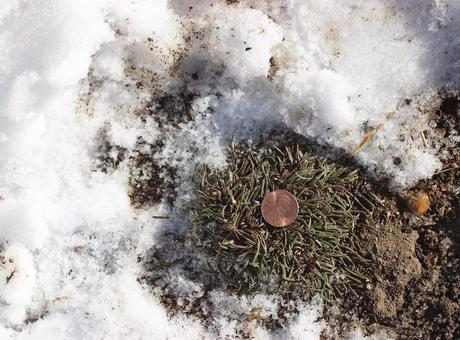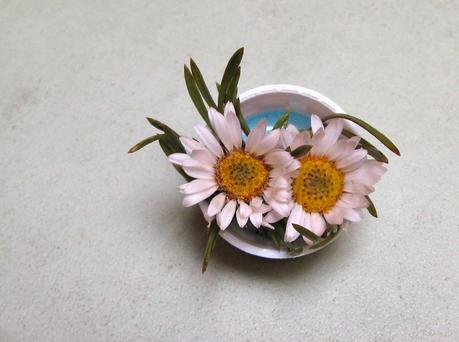
Easter daisies in foreground, to right of bunny tracks.
The Easter daisies are waiting ... waiting for spring. It may be January, but these guys are ready to go!Just look:

January 12, 2014
They keep green leaves all winter ... and already have flower buds, which formed last fall ...
and already have flower buds, which formed last fall ...
 so with the first sign of spring, sometime around Easter ...
so with the first sign of spring, sometime around Easter ... they will burst into bloom when the other prairie plants are just starting to grow.
they will burst into bloom when the other prairie plants are just starting to grow.
March 30, 2012. "Flowers" (heads) are about an inch across.
Their scientific name is Townsendia, and some people call them that -- townsendias. The Federal government calls them Townsend daisies (USDA Plants Database). There are at least 25 species, all native to western North America. Last May I rescued several Easter daisy plants from a grassland scheduled to become a road, and put them in a raised bed in the backyard. I quit watering them after only a week or so, and they did just fine. They're true xerophytes. Meanwhile, there's still no sign of road construction. Maybe I’ll transplant more townsendias this year.
Last May I rescued several Easter daisy plants from a grassland scheduled to become a road, and put them in a raised bed in the backyard. I quit watering them after only a week or so, and they did just fine. They're true xerophytes. Meanwhile, there's still no sign of road construction. Maybe I’ll transplant more townsendias this year.
May 30, 2013.
Some townsendias, mine for example, are tough to identify. So I collected a voucher specimen, took it to the Rocky Mountain Herbarium at the University of Wyoming, and compared it with descriptions in the literature and specimens in the collection. It is Townsendia hookeri, Hooker’s Easter daisy.
Compiled from Flora of North America.
Flowers of T. hookeri (above, left) are smaller than those T. exscapa (right), with which it’s often confused. Technically these are heads not flowers. Townsendias are composites (Asteraceae); what looks like a single flower is actually a head composed of many tiny flowers or florets.
Easter daisy heads, each with a cluster of yellow disk flowers surrounded by white ray flowers.
I mounted my voucher specimen last week. Soon it will be added to the 825,000 specimens already in the Rocky Mountain Herbarium.
 I’ve kept an eye on my Easter daisies as I walk by them every day, and I was amazed to discover that the little cushion plants over-winter with evergreen leaves and fully-formed flower buds. This is Wyoming and 7200 ft elevation ... how do they keep from freezing?! At least they’re low to the ground and out of the wind, and often protected by snow.
I’ve kept an eye on my Easter daisies as I walk by them every day, and I was amazed to discover that the little cushion plants over-winter with evergreen leaves and fully-formed flower buds. This is Wyoming and 7200 ft elevation ... how do they keep from freezing?! At least they’re low to the ground and out of the wind, and often protected by snow.“The flower buds remain green against any odds of winter weather and hurry toward bringing out every blossom within a few days” wrote Claude Barr, the great native plants gardener of the Great Plains (in Jewels of the Plains, 1983, University of Minnesota Press).Indeed, Easter daisies bloom before other plants have grown much at all, and thus can enjoy whatever sunshine spring offers. They’re buried with each spring blizzard, and then when the snow melts, they continue as before.

Easter daisies open as the morning warms. March 30, 2012.
There are many creatures named “Townsend” in this part of the world, including a solitaire (bird), ground squirrel, chipmunk, mole, vole, jack rabbit, and of course daisies. Most were named for John Kirk Townsend, one of the great 19th-century naturalists of North America, but John Kirk is not the Townsend of Easter daisy fame, though you will occasionally read otherwise. Townsendias were named for David Townsend, a prominent citizen of West Chester, Pennsylvania -- a banker, County Commissioner and enthusiastic botanist. He neither discovered nor named Townsendia, and it’s not clear that he ever saw one in the wild. The first collection on record was made by John Richardson in Saskatchewan. He called it Aster exscapa. When W.J. Hooker of the Royal Botanic Gardens reviewed the specimen, he decided it was sufficiently distinct to warrant its own genus, which he named in honor of Townsend:“I have named the genus in compliment to David Townsend, Esq. of West Chester, Pennsylvania who having imbibed the most ardent love of Botany from his friend and instructor Dr. Darlington of the same city, has devoted his leisure hours to the science with eminent success.” (Hooker, W.J. 1840. Flora Boreali-Americana: or, the Botany of the Northern Parts of British America, Volume 2)W.J. Hooker himself was honored when J.H. Beaman described and named Townsendia hookeri in 1957, based on a specimen from Mt. Vernon Canyon in Jefferson County, Colorado:
“To the layman, T. hookeri is perhaps as well known as any species of Townsendia. In Colorado it is abundant at the base of the Front Range and is one of the first flowers of the year; hence, its name Easter Daisy.”

An early spring bouquet.
Those lucky enough to catch Easter daisies in full flower adore them. Though low to the ground, they’re spectacular against the dull browns and grays of an early spring grassland. In Dakota Flora, Dave Ode suggests they would be the leprechauns’ favorite flowers if they grew in Ireland! I have to agree -- the little plants with their large clusters of bright blooms are enchanting. Claude Barr must have loved them too, judging by what he wrote:“Wintering as a completely evergreen bun of narrow leaves close to the ground, and guarding its quota of autumn-set buds, Townsendia joyously responds to the gentle light and warmth of early spring with wide disks and short rays of soft gold and glowing light pink. Fittingly, it is called ‘Easter-daisy’ ...”

South Dakota rancher Claude Barr, "eminent plantsman of the plains" (Great Plains Native Plant Society)

Spring's still a long way off ... best to put back their cover of snow.
